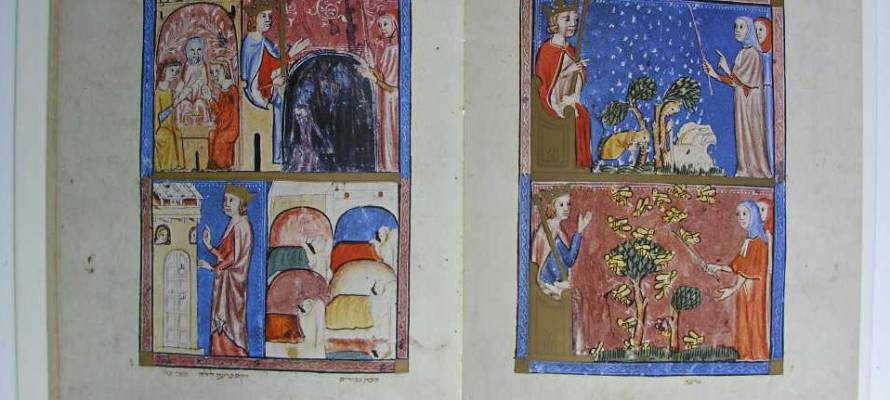The Sarajevo Hagaddah, one of the oldest Sephardic Haggadot in the world, was created in Barcelona in 1350.
The Sarajevo Haggadah endured the Spanish Inquisition, the Holocaust, and more recently, the Bosnian-Serb conflict in the 1990s despite numerous threats to its very existence, which is a story that continues to inspire and bring hope to Jews, Christians, and Muslims around the globe.
Indeed, the story of the survival of the Sarajevo Hagaddah is also that of the Jewish people. Just as the Jewish people, from the Exodus story, continued to exist and thrive against enormous odds, so too did the Sarajevo Hagaddah.
It is a beautifully illustrated manuscript full of medieval art work accompanying the written text of the Hagaddah. Hand-written in calf-skin and illuminated in both copper and gold, it was used by Spanish Jewish families during their Passover Seders in the medieval period.
Historians believe that the Sarajevo Hagaddah was rescued from Spain by Jews sometime following the 1492 expulsion and a note within the Hagaddah demonstrates that it made an appearance within Italy in the 1500’s.
Another note within the Sarajevo Hagaddah, dated 1609, claimed that the manuscript did not speak out against the Church, which probably saved it from being burned by the Inquisition as were many other Jewish books.
In 1894, the Sarajevo Hagaddah was sold to the National Museum of Bosnia and Herzegovina by a man named Joseph Cohen. How the Hagaddah traveled from Italy to Bosnia remains a mystery to date. Regardless, the Sarajevo Hagaddah remained within the National Museum of Bosnia and Herzegovina up until the Holocaust, when Nazis stormed the museum and demanded that the Sarajevo Hagaddah be turned over to them.
The museum’s director at the time, Jozo Petrovic, told the Nazis authorities that another Third Reich official was already in possession of the Sarajevo Hagaddah. The Nazis asked for the name of the Nazis official who took the Hagaddah, yet Petrovic merely replied, who was he to ask for the name of a Nazis officer?
Then, when the Nazis authorities left, Petrovic proceeded to hide the Sarajevo Hagaddah, entrusting the Sarajevo Hagaddah to Dervis Korkut, a Bosnian Muslim, who risked his own life by smuggling the Sarajevo Hagaddah out of the city.
Korkut gave it to a Muslim cleric, who then either hid the Sarajevo Hagaddah inside a mosque or under the floorboards of a Muslim home, thus allowing the Sarajevo Hagaddah to survive the Holocaust unscathed.
The Muslim community in Bosnia would eventually return the Sarajevo Hagaddah to the National Museum of Bosnia and Herzegovina once the Nazis left Bosnia in 1945.
However, another threat to the Sarajevo Hagaddah occurred in 1992, when Bosnian Serbs besieged Sarajevo with the goal of making it part of Greater Serbia. Snipers were every where on the streets of Sarajevo, randomly shooting people on site.
There were numerous power outages and food was scarce. Many buildings within the city were burnt to the ground, including one of the city’s prominent libraries.
The museum where the Sarajevo Hagaddah was stored was also attacked. Bosnia’s rich human heritage was at risk. Yet, Enver Imamovic, a Bosnian Muslim director of the National Museum of Bosnia and Herzegovina, decided that to risk his life in order to save the Sarajevo Hagaddah.
Braving bullets and mortars, he smuggled the Sarajevo Hagaddah out of the Museum and into a vault within the National Bank, where it would remain throughout the rest of the war.
In 2002, the Sarajevo Hagaddah went back to the National Museum of Bosnia and Herzegovina. It remained on display there until October 2012, when a funding issue, as well as political problems dating back to the Bosnian War, caused the National Museum of Bosnia and Herzegovina to close down.
However, the Sarajevo Hagaddah remains locked inside the museum to date. New York’s Metropolitan Museum of Art offered to host the Sarajevo Hagaddah for three years, but the Bosnian government declined the offer, citing the unresolved legal status of the National Museum of Bosnia and Herzegovina as the reason.
By Rachel Avraham


Do You Love Israel? Make a Donation - Show Your Support!
Donate to vital charities that help protect Israeli citizens and inspire millions around the world to support Israel too!
Now more than ever, Israel needs your help to fight and win the war -- including on the battlefield of public opinion.
Antisemitism, anti-Israel bias and boycotts are out of control. Israel's enemies are inciting terror and violence against innocent Israelis and Jews around the world. Help us fight back!




